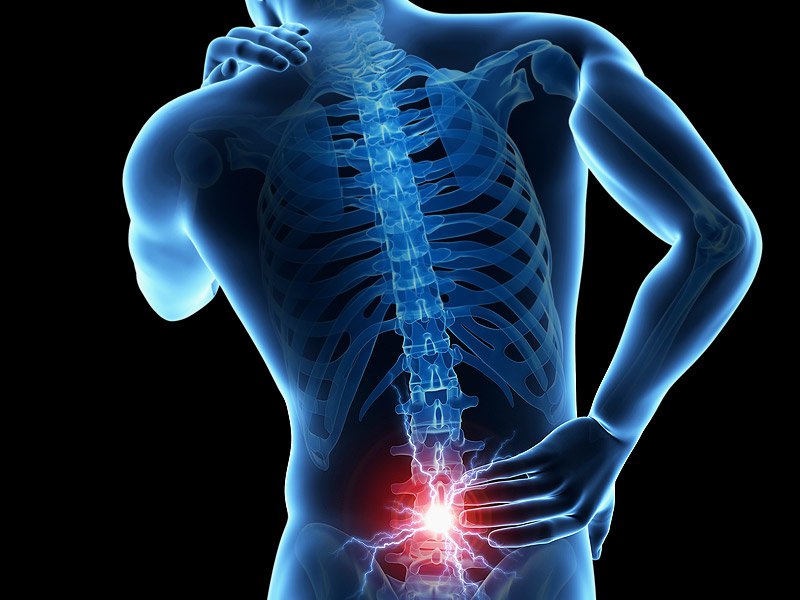By: DatelinehealthAfrica (DLHA) Staff Writer

Low back pain (LBP) is a very common bone and muscle (musculoskeletal) condition present worldwide in all races, gender and ages. It occurs broadly as pain or discomfort in the lower region of the back of spine closer to the buttocks.
Lower back pain is the most common form of back pain that many people experience in their day to day life. It is also called lumbago, and though it isn't a disease, it can have its repercussions on a person's life.
Globally, an individual will experience LBP at least once in his/her life span. If it continues for more than 3 months, it will be regarded as chronic back pain.
LBP is not life-threatening, but it is a leading cause of activity limitation and disability. It has substantial impact on the overall and financial well-being of an individual and society.
LBP results in significant losses in productivity at work and is associated with billions of dollars in medical expenditure annually, especially in middle and high income countries where medical cost data is available.

The prevalence of LBP worldwide is estimated to be between 30 and 80% among the general population and has been found to increase with age
In Africa, the average lifetime lower back pain prevalence (LBP) is 47% and this figure is believed to be rising. [1]
It is generally believed among researchers that a higher prevalence of LBP is associated with a lower socioeconomic status and lower education levels. [1]
It is however unclear if there is a cause-effect relationship between economic status and prevalence of LBP. Therefore, the postulation that the burden of LBP would be greater in lower and middle income countries (LMICs) like those situated in Africa remains unproven. Indeed, studies have shown that, the prevalence of LBP in Africa was comparable to that of developed and high income nations [2]
Back pain occurs if the person is experiencing some problems with one or many other parts of the lower back such as:
The following will put you at high risk for low back pain:
An obese black man with a tape measure aroung the abdomen. Click on image to enlarge
The major symptoms associated with back pain include:
Other symptoms that require urgent medical attention include:
To help your doctor make accurate diagnosis of the nature of your low back pain, be sure to provide the following specific information:
Following a good history, your doctor will examine you fully.
You may be asked to stand, walk and perform a range of motions while your doctor watches you for any limitations or disability and also asks for any pain arising from the movements performed.
You may also be asked to lie on a couch while your doctor attempts to raise your extended legs up and asks you if you have any back pains and if the pain radiates anywhere into your legs.
A full neurological exam may also be performed to test for muscle weakness in your lower limbs or loss of sensation to touch and pain over the skin of your lower limbs.
An X-ray or CT scan of the bones of the back may be ordered by your doctor to assess for fracture or any other problems that may affect the vertebral bones and associated muscles and ligaments.
.jpg)
There are various preventive measures you can undertake to ensure you aren't troubled by back pain:
There are three broad approaches to treating low back pain; non-medication; medication, and surgical (see table 1).
Table 1 showing a listing action steps for the management of low back management. Click on image to enlarge.
X-ray guided lower vertebrae facet injectionf for the control of pain. Click on image to enlarge.
There's an old saying "Prevention is better than cure"; hence, you must identify the red flags of back pain on time to prevent any potential damages and take proper treatment to cure back pain before it worsens.
1. Morris, L.D., Daniels, K.J., Ganguli, B., Louw, Q.A. An update on the prevalence of low back pain in Africa: a systematic review and meta-analyses. BMC Musculoskelet Disord. 2018; 19: 196.
2. Louw Q.A., Morris LD, Grimmer-Somers K., The prevalence of low back pain in Africa: a systematic review. BMC Musculoskel Disord. 2007; 8:105.
Published: December 12, 2019
Last updated: January 30, 2024
© 2019. Datelinehealth Africa Inc. All rights reserved.
Permission is given to copy, use and share content for non-commercial purposes without alteration or modification and subject to attribution as to source.
DATELINEHEALTH AFRICA INC., is a digital publisher for informational and educational purposes and does not offer personal medical care and advice. If you have a medical problem needing routine or emergency attention, call your doctor or local emergency services immediately, or visit the nearest emergency room or the nearest hospital. You should consult your professional healthcare provider before starting any nutrition, diet, exercise, fitness, medical or wellness program mentioned or referenced in the DatelinehealthAfrica website. Click here for more disclaimer notice.